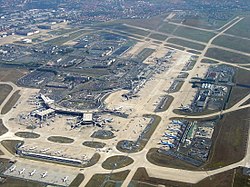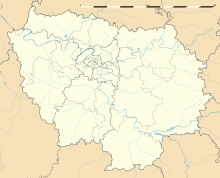Paris Orly Airport (French: Aéroport de Paris-Orly) (IATA: ORY, ICAO: LFPO) is one of two international airports serving Paris, France, the other one being Charles de Gaulle Airport (CDG). It is located partially in Orly and partially in Villeneuve-le-Roi, 13 km (8.1 mi) south[2] of Paris. It serves as a secondary hub for domestic and overseas territories flights of Air France and as the homebase for Transavia France. Flights operate to destinations in Europe, the Middle East, Africa, the Caribbean, South America and North America.
Paris Orly Airport Aéroport de Paris-Orly | |||||||||||||||||||
|---|---|---|---|---|---|---|---|---|---|---|---|---|---|---|---|---|---|---|---|
 | |||||||||||||||||||
 | |||||||||||||||||||
| Summary | |||||||||||||||||||
| Airport type | Public | ||||||||||||||||||
| Owner | Groupe ADP | ||||||||||||||||||
| Operator | Paris Aéroport | ||||||||||||||||||
| Serves | Paris metropolitan area | ||||||||||||||||||
| Location | Essonne and the Val-de-Marne, France | ||||||||||||||||||
| Opened | 1932 | ||||||||||||||||||
| Hub for | |||||||||||||||||||
| Operating base for | |||||||||||||||||||
| Built | 1 January 1918 | ||||||||||||||||||
| Elevation AMSL | 291 ft / 89 m | ||||||||||||||||||
| Coordinates | 48°43′24″N 02°22′46″E / 48.72333°N 2.37944°E | ||||||||||||||||||
| Website | www | ||||||||||||||||||
| Maps | |||||||||||||||||||
 FAA airport diagram (2005) | |||||||||||||||||||
Location of airport in Île-de-France region | |||||||||||||||||||
| Runways | |||||||||||||||||||
| |||||||||||||||||||
| Statistics (2023) | |||||||||||||||||||
| |||||||||||||||||||
Before the opening of Charles de Gaulle Airport in 1974, Orly was the main airport of Paris. Even with the shift of most international traffic to Charles de Gaulle Airport, Orly remains the busiest French airport for domestic traffic and the second busiest French airport overall in passenger traffic, with 33,120,685 passengers in 2018.[3] The airport is operated by Groupe ADP under the brand Paris Aéroport.
Location edit
Orly Airport covers 15.3 km2 (5.9 sq mi) of land. The airport area, including terminals and runways, spans over two départements and seven communes:
- Essonne département: communes of Paray-Vieille-Poste (West Terminal and half of South Terminal), Wissous,[4] Athis-Mons,[5] Chilly-Mazarin,[6] and Morangis;[7]
- Val-de-Marne département: communes of Villeneuve-le-Roi[8] and Orly (half of South Terminal).[9]
Management of the airport, however, is solely under the authority of Aéroports de Paris, which also manages Charles de Gaulle Airport, Le Bourget Airport, and several smaller airports in the suburbs of Paris.
History edit
First years edit
Originally known as Villeneuve-Orly Airport, the facility was opened in the southern suburbs of Paris in 1932 as a secondary airport to Le Bourget. Before this two huge airship hangars had been built there by the engineer Eugène Freyssinet from 1923 on.[citation needed]
World War II edit
As a result of the Battle of France in 1940, Orly Airport was used by the occupying German Luftwaffe as a combat airfield, stationing various fighter and bomber units at the airport throughout the occupation.[10] Consequently, Orly was repeatedly attacked by the Royal Air Force and United States Army Air Forces (USAAF), destroying much of its infrastructure, and leaving its runways with numerous bomb craters to limit its usefulness to the Germans.[citation needed]
After the Battle of Normandy and the retreat of German forces from the Paris area in August 1944, Orly was partially repaired by USAAF combat engineers and was used by Ninth Air Force as tactical airfield A-47. The 50th Fighter Group flew P-47 Thunderbolt fighter-bomber aircraft from the airport until September, then liaison squadrons used the airfield until October 1945.[11]
Post-war edit
The USAAF diagram from March 1947 shows the 6,140-foot (1,870 m) 27/207 (degrees magnetic) runway (later 03R) with 5,170-foot (1,580 m) 81/261 runway (later 08L) crossing it at its north end. The November 1953 Aeradio diagram shows four concrete runways, all 197 feet (60 m) wide: 03L 7,874 ft (2,400 m), 03R 6,069 ft (1,850 m), 08L 5,118 ft (1,560 m) and 08R 6,627 ft (2,020 m).[citation needed]
The American United States Army Air Forces 1408th Army Air Force Base Unit was the primary operator at Orly Field until March 1947 when control was returned to the French Government. (The United States Air Force leased a small portion of the Airport to support Supreme Headquarters Allied Powers Europe (SHAPE) at Rocquencourt). The Americans left in 1967 as a result of France's withdrawal from NATO's integrated military command, and all non-French NATO forces were asked to leave France.[12]
In May 1958, Pan Am Douglas DC-7Cs flew to Los Angeles in 21 hr 56 min; Trans World Airlines, Air France and Pan Am flew nonstop to New York in 14 hrs 10–15 min. Air France flew to Tokyo in 31 hr 5 min via Anchorage or 44 hr 45 min on a seven-stop Lockheed Constellation (1049G model) via India. Air France's ten flights a day to London were almost all Vickers Viscounts; the only other London flight was Alitalia's daily Douglas DC-6B (BEA was at Le Bourget).[citation needed]
A development project voted in 2012 planned to merge the airport's south and west terminals with the construction of an 80,000-square-metre (860,000 sq ft) building to create one great terminal.[13] On 14 April 2016, the Groupe ADP rolled out the Connect 2020 corporate strategy and the commercial brand Paris Aéroport was applied to all Parisian airports, including the Orly airport.[14]
On 7 November 2015, the failure of a two-decade-old Windows 3.1 system which was responsible for communicating visual range information in foggy weather to pilots caused a temporary cease of operations. Whether the failure was hardware- or software-based is not specified, though the highlighting of the operating system suggests a software failure.[15]
As part of the COVID-19 pandemic and its impact on aviation, the airport was closed to all commercial traffic from 1 April 2020 to 25 June 2020.[16][17] During this period, commercial traffic and flights were relocated to Charles de Gaulle Airport, while Orly was still used for State flights, emergency diversions, and medical evacuations.
In October 2023, it was announced that Air France will largely cease using Orly Airport by summer 2026, with only one public service obligation flight to Corsica to remain.[18][19]
Terminals edit

Terminals 1 and 2 edit
Known as the West Terminal until March 2019, these two terminals consist of two floors and a gate area of four "fingers" rather than a brick-style layout. The ground level 0 features the arrivals facilities including eight baggage reclaim belts as well as several service facilities and shops. The departures area is located on level 1 with more stores and restaurants located here. This central departures area is connected to three gate areas split between Orly 1 (A and B gates) and Orly 2 (C gates).[20] 23 stands at this terminal are equipped with jet-bridges, with several of them also able to handle wide-body aircraft.[21]
Terminal 3 edit
Inaugurated in April 2019, Terminal 3 is a junction building between Terminals 1, 2 and 4. The terminal allows customers to travel between all areas of the airport under one roof. It includes around 5,000 sqm of duty-free shopping along with several restaurants and lounges. It houses gates D and E, with direct access to Orly 4 departure gates.[22]
Terminal 4 edit
Formerly known as the South Terminal this innovative 1961 steel-and-glass terminal building consists of six floors. While the smaller basement level −1 as well as the upper levels 2, 3 and 4 contain only some service facilities, restaurants and office space, level 0 features the arrivals facilities as well as several shops and service counters. The airside area and departure gates are located on the upper level 1. The waiting area, which features several shops as well, houses gates E and F.[20] 15 of the terminal's departure gates are equipped with jet-bridges, some of which are able to handle wide-body aircraft.[21]
Airlines and destinations edit
The following airlines operate regular scheduled and charter flights at Orly Airport:
Statistics edit
Graphs are unavailable due to technical issues. There is more info on Phabricator and on MediaWiki.org. |
Other facilities edit
AOM French Airlines had its head office in Orly Airport Building 363 in Paray-Vieille-Poste.[44][45][46] After AOM and Air Liberté merged in 2001,[47] the new airline, Air Lib, occupied building 363.[48]
Ground transportation edit




Train edit
Orly Airport is directly served by two train lines, which offer connections to the larger Paris transportation network:
- Tramway T7 connects to Terminal 4, and offers service to Villejuif-Louis Aragon station on Paris Métro Line 7.
- Orlyval people mover line that connects two stations at Orly terminals (Orly 1, 2, 3 station and Orly 4 station) with Antony station, served by the RER B line. Passengers can also transfer to Tramway T7 at Orly 4 station. Orlyval is free to use between the two stations at Orly; however a premium fare is charged between Antony and Orly Airport (the suburb of Antony is about 5 km from the airport).
As part of the Grand Paris Express project, Aéroport d'Orly station is under construction, planned to open in June 2024. It will be served by a new extension of Line 14, linking the airport directly to Paris in as little as 16 minutes. From 2027, the station will also be served by Line 18, connecting the airport to Massy-Palaiseau and Paris-Saclay.
Car edit
Orly Airport is connected to the A106 autoroute (spur of the A6 autoroute).
Buses and coaches edit
- OrlyBus direct to Denfert-Rochereau station
- Disneyland Magical Shuttle direct to Disneyland Paris
- RATP bus 183 to Rungis International Market via Pont de Rungis–Aéroport d'Orly station (connection to RER C) and Robert Peary station (connection to Tramway T9)
- Albatrans bus 91-10 to Saint-Quentin-en-Yvelines–Montigny-le-Bretonneux station (connection to Transilien) via Massy-Palaiseau station (connection to TGV)
- Noctilien night buses:
- N22 to Paris (Châtelet–Les Halles station)
- N31 to Paris (Gare de Lyon)
- N131 to Paris (Gare de Lyon) via Brétigny station
- N144 to Paris (Gare de l'Est) via Corbeil-Essonnes
Environmental improvements edit
Paris Aéroport reported in 2023 that a tree-planting project in the vicinity of the airport, along the route of the route nationale 7, was being undertaken. The scheme involved planting 900 tree species and 14,000 forest seedlings. Paris Aéroport anticipates capturing 329 tonnes of carbon per year through the planting.[49]
Accidents and incidents edit
- On 10 February 1948, SNCASE Languedoc P/7 F-BATH of Air France was damaged beyond economical repair at Orly Airport.[50]
- On 20 September 1952, a USAF Douglas C-47 Skytrain on final approach to ORY struck a telephone pole, rooftops and crashed and caught fire 1 km (0.6 mi) from ORY. Three of the four occupants on board died.[51]
- On 27 November 1953, a USAF Fairchild C-119 Flying Boxcar crashed 4 km (2.5 mi) NE of ORY on approach, crashing in flames in the Cholsy-le-Roy neighborhood of Paris. The cause was the rear clam shell doors broke off striking the horizontal stabilizer, causing a catastrophic failure of the empennage. All six occupants were killed.[52]
- On 24 November 1956, Alitalia Flight 451, a Douglas DC-6 crashed 0.6 km (0.4 mi) W of ORY moments after takeoff, some 10–15 seconds later altitude was lost and the DC-6 struck a house 600 m past the runway end. All 10 crew and 34 of the 35 passengers were killed. Cause unknown.[53]
- On 21 January 1957, a SNCASE Armagnac crashed attempting to land at night with instrument landing system monitored by GCA. One crewmember and one passenger out of the 70 on board died.[54]
- On 19 May 1960, an Air Algérie Sud Aviation Caravelle collided with a Stampe SV.4 biplane on final approach about 8 miles SE of Orly. Despite suffering substantial damage, the Caravelle landed safely at Orly with no fatalities but the Stampe biplane crashed, killing the pilot.[55]
- On 3 June 1962, Air France Flight 007, a chartered Boeing 707 named the Chateau de Sully bound for Atlanta, US, crashed on take-off with 132 people on board; 130 of them were killed. The only survivors were two flight attendants seated in the rear of the plane. The charter flight was carrying home Atlanta's civic and cultural leaders of the day. At the time, this was the highest recorded death toll for an incident involving a single aircraft.
- On 11 July 1973, Varig Flight 820, a Boeing 707, made a forced landing due to fire in a rear lavatory, incoming from Rio de Janeiro–Galeão. The aircraft landed 5 kilometers short of the runway, in a full-flap and gear down configuration. Due mainly to smoke inhalation, there were 123 deaths whilst 11 people survived (10 crew, one passenger).[56][57]
- On 3 March 1974, Turkish Airlines Flight 981, in an event known as the "Ermenonville air disaster", crashed in Ermenonville forest after take-off from Orly on a flight to London's Heathrow Airport when an improperly closed cargo door burst open. The explosive decompression that resulted brought down the McDonnell Douglas DC-10. All 346 people on board were killed, making the accident one of the deadliest in aviation history.
- On 20 October 2022, Amelia International Flight 8R1217, an Embraer ERJ 145, suffered damage after skidding off the runway 25 whilst landing during a storm by night. None of the 42 people onboard were injured.[58]
edit
- On 13 and 19 January 1975, a series of RPG attacks by Popular Front for the Liberation of Palestine caused collateral damage and injured 23.
- On 30 September 1977, an Air Inter Sud Aviation Caravelle was hijacked by a man armed with a pistol and a hand grenade and returned to Orly Airport. After about eight hours police marksman fired tear gas grenades and stormed the plane. The hijacker lobbed a hand grenade toward the cockpit, killing one passenger. A shot was fired and the hijacker was arrested.
- On 20 May 1978, three terrorists armed with submachine guns opened fire at the El Al boarding gate, killing five and injuring five.
- On 15 July 1983, a bombing of a Turkish Airlines check-in counter by ASALA killed eight people and injured 55.
- On 18 March 2017, a man attempted to grab the gun of a soldier who was patrolling the airport as part of Opération Sentinelle. The attacker was shot and killed.
Notes edit
References edit
Sources edit
- McAuliffe, Jerome J.: U.S. Air Force in France 1950–1967 (2005), Chapter 14, "Paris-USAF Operations".
External links edit
 Media related to Paris-Orly Airport at Wikimedia Commons
Media related to Paris-Orly Airport at Wikimedia Commons![]() Paris Orly Airport travel guide from Wikivoyage
Paris Orly Airport travel guide from Wikivoyage
- Official website
- Orly Airport aviation weather (in Spanish, English, French, and Chinese)



